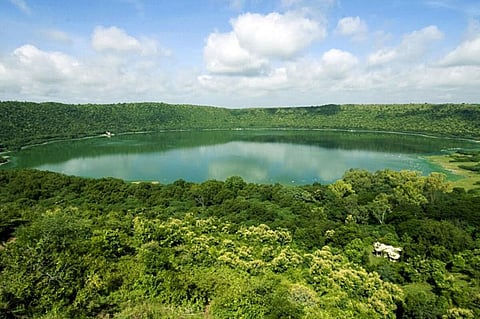
- Home
- न्यूजग्राम
- India
- World
- Politics
- Entertainment
- Culture
- Lifestyle
- Economy
- Sports
- Sp. Coverage
- Misc.
- NewsGram Exclusive
- Jobs / Internships

The Mother Nature is full of natural wonders, from hills and valleys to rivers and oceans, from the hundreds and thousands of species of plants and animals to the wind, breeze and sky, nature is what makes this world worth living in.
The Lonar Lake that is saline and alkaline at the same time- this unique combination makes the lake pretty unique. It is located at Lonar in Buldhana district, Maharashtra, India. That is something that you don't really see on a fairly regular basis and has been subject to scientific studies for a very long time. To know more about it, many geologists, archaeologists, naturalists and astronomers have published studies of various aspects of this Lonar Crater Lake ecosystem. The lake is also known as 'Lonar Sarovar.'
Lonar Lake Mystery
This peculiar lake is one of its kinds, not only in India but on the planet, which kept it pretty well-preserved for thousands of years. It was created by a meteor impact during the Pleistocene Epoch and it is the only known hypervelocity impact crater in basaltic rock anywhere on Earth. Lonar Lake is said to be one of Maharashtra's best-kept secrets as not many people know about this magnificent phenomenon.
The Lonar Lake was formed when a blazing ball of fire crashed into the earth at an estimated speed of 90,000 km per hour. Wikimedia Commons
The Lonar Lake mystery still perplexes many. The estimated age of the lake is said to be a topic of contention. Generally, the Lonar Lake is believed to be 50,000 incredibly years old but according to some studies, gives an age of 570,000 years. Geological Society of India has conducted extensive studies of the site. Later in 2007, the biological nitrogen fixation nature of Lonar Lake was also discovered.
The circular depression bears a saline water lake in its central portion. It was formed when a blazing ball of fire crashed into the earth at an estimated speed of 90,000 km per hour. This hit resulted into eruption and spewing molten rock to create a magnificent crest on the rim. With the gentle passage of time, green cover took over in the surrounding of the lake and a perennial stream transformed the crater into a tranquil, emerald green lake.
Lonar Lake Tourism
The land-locked water body is an exceptional 'bowl of biodiversity' and a wildlife sanctuary with a unique ecology that is vastly different from the surrounding flat landscape and supports micro-organisms rarely found elsewhere on earth. At first, it was believed that the lake was of volcanic origins but further studies proved that the lake was sitting in a crater formed by extraterrestrial impact. The presence of maskelynite and the planar deformation features are not part of volcanic origins. Thus, it leads to the abandoning of volcanic origin theory.
The land-locked water body is an exceptional 'bowl of biodiversity' and a wildlife sanctuary. Wikimedia Commons
Here 10 facts about Lonar lake, which will help you to dwell more of its origins and unique features.
According to NASA, the crater's volcanic basalt makes Lonar a well similar to that of impact craters on the surface of the Moon. Wikimedia Commons
The visitors have to trek through the dense forest to reach this marvellous location. One can experience wide varieties of flora and fauna over here. Birds like the Black-winged Stilts, Brahminy ducks and Bay Weavers among others can be spotted here regularly. Even Bats, Langur, Gazelles and Chikaras makes a visit here regularly.
A series of a low hill around the crater basin sits with an 8 kilometres circumference on the top. The side area of the basin has a steep rise of 75 degrees and is covered with multiple rings of trees. Each ring of the tree is made up of a specific species of tree. For instance, the first and outermost ring is of date palms.
